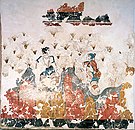Portal:Gardening/Selected article/2

The history of saffron in human cultivation and use reaches back more than 3,000 years and spans many cultures, continents, and civilizations. Saffron, a spice derived from the dried stigmas of the saffron crocus (Crocus sativus), has remained among the world's costliest substances throughout history. With its bitter taste, hay-like fragrance, and slight metallic notes, saffron has been used as a seasoning, fragrance, dye, and medicine. Saffron is native to Southwest Asia, but was first cultivated in Greece.The wild precursor of domesticated saffron crocus is Crocus cartwrightianus. Human cultivators bred C. cartwrightianus specimens by selecting for plants with abnormally long stigmas. Thus, sometime in late Bronze Age Crete, a mutant form of C. cartwrightianus, C. sativus, emerged. Saffron was first documented in a 7th-century BC Assyrian botanical reference compiled under Ashurbanipal. Since then, documentation of saffron's use over a span of 4,000 years in the treatment of some ninety illnesses has been uncovered. Saffron slowly spread throughout much of Eurasia, later reaching parts of North Africa, North America, and Oceania.
